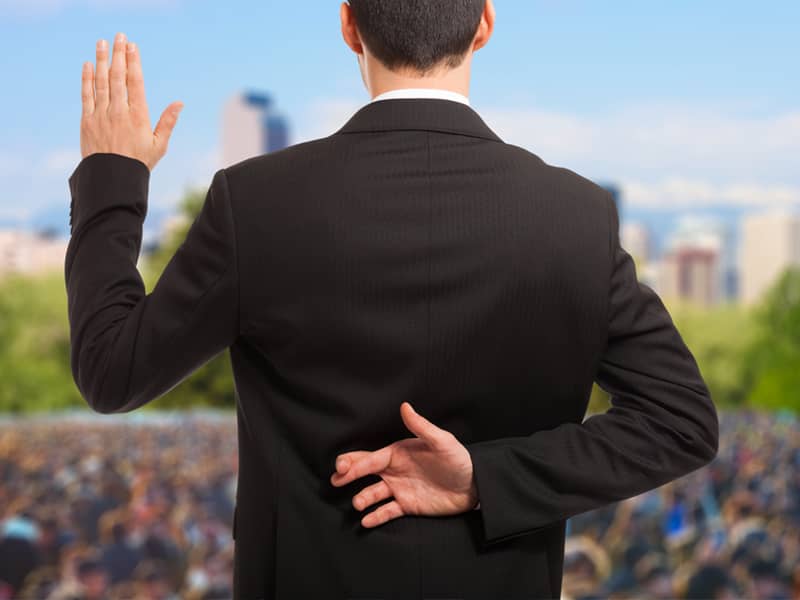That's what young wiseguys across the United States used to say every morning during the Pledge of Allegiance, before Congress added the phrase "under God" in 1954.
The new pledge was part of a broad nationwide campaign--in culture, politics, and education--to promote shared religious values among diverse Americans. These were the years when Hollywood blockbusters included "The Ten Commandments" and "A Man Called Peter"; when songs like "The Man Upstairs" and "Big Fellow in the Sky" climbed to the top of the charts; when Congress set aside funds for its own prayer room; and when President Dwight D. Eisenhower famously remarked that Americans required "a deeply felt religious faith--and I don't care what it is."
A half-century later, it would seem, America has achieved precisely the consensus that Eisenhower envisioned. How else to explain the bipartisan vituperation that greeted last week's decision by the United States Court of Appeals for the Ninth Circuit, which ruled the 1954 pledge unconstitutional?
In a rare display of unity, the Senate voted 99 to 0 to condemn the decision. Not to be outdone, House members gathered on the steps of the Capitol to recite the pledge--and to sing "God Bless America." President Bush deemed the ruling "ridiculous"; Senate majority leader Tom Daschle termed it "nuts"; and West Virginia Senator Robert C. Byrd--the only current member of Congress who was in the House when it added "under God" to the pledge--called the Ninth Circuit judges "stupid."
As in the 1950s, though, this apparent consensus masks some very profound differences. To understand why, we might revisit another, less successful religious legacy of the same era: "non-denominational" school prayer.
The roots of non-denominational prayer lay in America's encounter with Nazism during World War II, which starkly illuminated the perils of religious hatred. To prevent such prejudice from developing on our own shores, some educators argued, schools needed to emphasize the religious traditions that Americans held in common.
Some religious groups simply removed these classes to private facilities, where they remain to this day. But others sought to infuse the regular school curriculum with shared religious values.
Particularly in large cities, schools responded by instituting Bible reading and the Lord's Prayer. In 1952, the Supreme Court let stand a lower court decision declaring that both practices were "non-sectarian"--and hence constitutional.
But Jews, especially, objected to the obvious Christian themes of the Lord's Prayer. In New York, then, the State Board of Regents devised a prayer that supposedly satisfied every world faith: "Almighty God, we acknowledge our dependence upon Thee, and we beg Thy blessings upon us, our parents, our teachers, and our Country."
Jews continued to condemn the Regents' prayer and other so-called common devotionals, fearing that any religious exercises would allow Christians to "bootleg" their own faith into the public schools. Non-denominational prayers also drew fire from the nation's burgeoning fundamentalist movement, which worried that the Regents' prayer was not Christian enough. "With Jews, Roman Catholics, Mormons, and other religious interests represented in the schools, Jesus Christ as the Messiah and Saviour of men could not be taught," fumed one fundamentalist spokesman in 1957. "Any religion that is worthy of the name must present the way of everlasting life."
The Supreme Court would strike down the Regents' prayer in its 1962 decision, Engel v. Vitale, which declared that any organized school prayer violated the Establishment Clause of the Constitution. A firestorm of protest and counter-protest ensued, exposing the tensions and recriminations that lurked beneath America's postwar consensual facade. On the Right, critics linked the Court's prayer decision to its rulings on school desegregation: as one Southern Congressman complained, the Court "put the Negro in the schools, and took God out." Fearful of eroding the Court's fragile authority on race, civil rights groups and liberal mainline churches rallied in support of the prayer ruling.
Today, by contrast, liberals are fearful of jeopardizing their precarious legislative agenda as well as their post-9/11 patriotic bonafides. So they have heaped abuse on the Ninth Circuit, joining hands with conservatives to rally around the Pledge of Allegiance.
But we must not mistake our apparent unanimity for actual consensus. No matter what our leaders say, millions of Americans--including Hindus, Buddhists, and atheists--do not believe in a single God. If schools cannot sponsor prayers to "Almighty God," why should they be allowed to salute Him in a daily pledge?
Thus far, no prominent liberal voice has dared to ask this simple question. Sooner or later, though, one naked individual with have the courage to do so. Others will follow. And once again, we will discover how much we disagree over God--no matter who really lives under Him.

